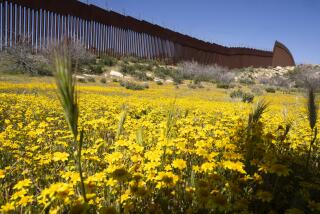Mapping Biological Diversity
- Share via
Imagine starting a drive from Los Angeles to Boston, lacking a road atlas or even a rental car map. Your only navigational tool is a giant wall map of the entire United States crumpled on the seat beside you, the scale so grand it reveals nothing smaller than interstate highways--and even they are barely discernible.
That image sums up how map makers historically have depicted the world’s natural tapestry of forests, deserts, mountains and oceans. Such maps have been too broad and coarse to capture the complex mix of animals and plants found around the globe.
Before we set out to save the world, we need to know what lives in it, and where, said Eric Dinerstein, chief scientist at the World Wildlife Fund, one of the world’s largest private conservation groups. He still remembers the advice of one scientific veteran: “The first thing you’re going to need, to do conservation, is to go out and get a good map.”
When Dinerstein and colleague David M. Olson couldn’t find the right map, they decided to design one, launching an eight-year effort that would involve the work of more than 1,000 biogeographers, taxonomists, conservationists and ecologists nationwide.
The result: what they call “A New Map of Life on Earth.”
Their creation is described in an article appearing today in the journal BioScience. Both its creators and independent scientists call the map a significant advance in understanding the ecological tapestry of the globe. Building on earlier research by many scientists, the project was led by Dinerstein and Olson, currently director of the fund’s conservation science program.
The map they designed serves as what Dinerstein calls a jigsaw puzzle of the Earth constructed by biologists.
“Behind this paper is a colossal amount of work,” said Stuart L. Pimm, professor of conservation biology at Columbia University and author of “The World According to Pimm: A Scientist Audits the Earth.” While most biologists are focusing narrowly on specific plants, animals and ecosystems, Olson and Dinerstein have stepped back and captured both the small-scale and large-scale perspectives.
“Everyone’s looking at the trees, and the World Wildlife Fund and this team decided they ought to look at the woods and map out where those forests are,” said Pimm.
What can be startling to the first-time viewer is the sheer number of forests on the map, along with deserts, steppes, grasslands, mountain ranges and every other natural landscape. The map starts by slicing the world into eight biogeographic realms. They in turn are divided into 14 biomes, ranging from mangroves to temperate coniferous forests.
Then the map makers pinpoint 867 ecoregions, four times more than identified in earlier studies. Each ecoregion is distinguished by such common characteristics as climate, plants, animals, soil type and geological features. On the list of 867 are ecoregions as disparate as the Central Zambezian Miombo woodlands in Central and East Africa--roamed by elephants, black rhinos and sable antelopes--and the conifer woods of the Klamath-Siskiyou region that straddles the Oregon-California border.
For the biologist on the metaphorical cross-country trek, this is a road map that not only shows the ecological equivalent of state highways and back roads, but also reveals the nameless dirt tracks that snake across deserts and through forests.
The result is more like a database than a paper map to be hung on a laboratory wall. With much of the results posted on the World Wildlife Fund’s Web site, even elementary school students can aim the map pointer at the center of South America, click and read about the Cerrado, the largest ecoregion in the Americas, a savanna shrubland unusually rich in plants and animals that stretches across parts of southern Brazil, northeastern Paraguay and eastern Bolivia.
The same map pointer, placed atop Afghanistan, reveals details about the Central Afghan Mountains dry woodlands. Groves of pistachio trees are found here, along with jungle cats, wild pigs and the Siberian crane, which some call the most endangered crane in the world. The World Wildlife Fund has labeled this Florida-sized ecoregion “critical/endangered,” not because of the current war but because of threats to it from timber cutting and soil erosion.
The map reflects a vision of the world that transcends political boundaries and focuses instead on biological geography. It can encourage people to think of ecoregions as the natural neighborhoods in which they live.
“I grew up in New Jersey, but it’s much more interesting to say I grew up in the Atlantic coastal pine barrens,” Dinerstein said. His mother lives not only in North Miami Beach but also in the Florida pine rocklands.
Pine barrens and coastal sage get short shrift in most studies of biological diversity and rare species. Scientists and schoolchildren alike focus on the notion of saving tropical regions, especially the Amazonian rain forest, which has evolved into the most popular icon of endangered wildlife and even inspired its own flavor of ice cream.
As the new map shows, many lesser-known areas are both biologically significant and threatened, said Reed Noss, president of Conservation Science Inc. and immediate past president of the Society for Conservation Biology.
One such spot is the Klamath-Siskiyou region, which contains the third-highest variety of conifer trees in the world, after one area in China and another in Mexico. It is home to more than 200 plants that are endemic, meaning they are found nowhere else.
By showing that the plants are found only in this one place, the map makes the point that if they disappear, they will be gone from the Earth.
The Brewers’ spruce, commonly known as weeping spruce, is found only in the Klamath-Siskiyou region. So is the Port Orford cedar, now threatened by a root-disease fungus spread by the tires of logging trucks and other vehicles, said Noss, who led a 1999 study of the Klamath-Siskiyou area.
Information on the map about such forested areas could help timber companies decide where to harvest logs.
Dinerstein recalled how the World Bank brought together timber companies and conservationists to discuss forest preservation around the world. The companies’ first question: “Tell us where we shouldn’t log” and their second was, “Tell us where to operate,” he said.
“To do that, the maps we had certainly weren’t adequate,” Dinerstein said. But the new terrestrial mapping system should provide a way of seeing which forests are in the greatest danger of disappearing.
As Olson described it: “We finally have a Hubble telescope to look at the Earth.”






